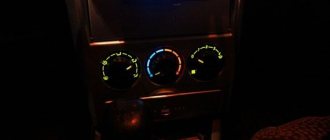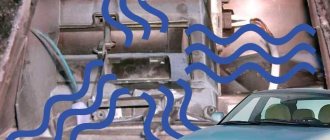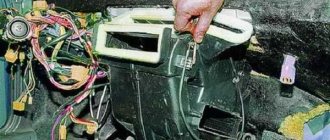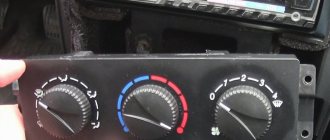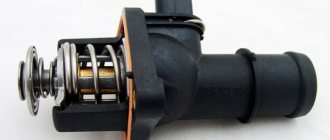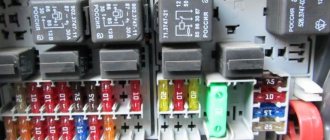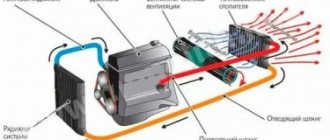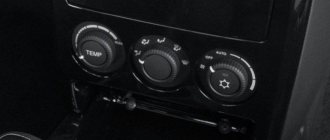Causes of cold air from the stove
There are quite a few reasons why the heater can blow cold air, and to determine the specific cause, you will have to tinker a little with the car in order to correctly diagnose the breakdown.
List of reasons:
- The heater radiator is clogged;
- The damper position gearmotor is broken;
- Thermostat is faulty;
- Insufficient amount of coolant;
- The expansion tank cap is faulty;
Let's look at each of the reasons in more detail and start with the most primitive ones.
Failure of the expansion tank cap
The expansion cap is a plug that prevents splashing of coolant in the engine compartment, but this is not its only task. The lid has a built-in valve in its design that relieves excess pressure and allows the required amount of air into the system so that vacuum and vacuum are not created in it. If the cap valve is faulty, then in cold weather a vacuum may be created in the cooling system, which will prevent good circulation through the heater radiator, and this will lead to insufficient heating of the radiator.
When unscrewing the plug, it is necessary to check its external condition; there should be no rust or traces of oxide on it. If the valve becomes stuck, the cover must be replaced.
Thermostat is faulty
If the thermostat malfunctions, the car will take quite a long time to warm up in the cold season. This is due to the fact that the coolant will circulate in a large circle through the cooling radiator and it will be much more difficult for the engine to warm up to operating temperature. As you know, the lower the temperature of the engine and coolant, the colder it blows from the stove.
You can check the thermostat by starting the car and letting it run for 10 minutes, and then touch the lower radiator hose, it should be cold until the car warms up to operating temperature. If the lower radiator hose warms up evenly with the upper one, this means that the thermostat is stuck in the open position and needs to be replaced.
Heater radiator clogged
When the heater radiator is clogged, the circulation of coolant through it becomes much worse, which leads to insufficient heat exchange. A clogged radiator occurs as a result of neglecting to replace the coolant for a long time.
Checking for a clogged radiator can be done by touching the pipes supplying coolant to it; they should both be hot, but if one of them is hot and the other is cold, then most likely the radiator is clogged. The check should be carried out with the heater fan turned off.
This condition is met if the air flow from the air ducts is of sufficient strength, but cold. If the flow is weak but hot, then most likely it is necessary to replace the cabin filter.
Fan doesn't work
If during the check it turns out that air is not entering the cabin at all, take the following steps:
- Check whether fuse F9 is good or not. It may have burned out, causing no voltage to be supplied to the device.
- Make sure the fan is working properly. In this case, try to repair it or replace it immediately.
- Change the resistance if it is causing the fan to not operate properly.
- Make sure the controller is working.
- Clean the fan. There are situations when the device becomes clogged, causing it to not work or making increased noise during rotation.
- The fan relay is burnt out. If none of the tips discussed above helped, check the relay, the appearance of which can be used to judge its serviceability. If something is burnt inside, this indicates the need for replacement. After this, the Priora stove fan should start working.
- We wrote about the cabin filter above.
If the remaining components of the Priora stove are functioning normally, the cause may be a failure of the temperature sensor.
Damper position motor
This breakdown occurs quite often on Priora. The heater damper position motor reducer is a DC motor that rotates to move the damper, which opens the air flow through the radiator. Often after the summer season, when the damper remains in the open position for a long time, the motor rusts and can no longer rotate, and therefore cannot move the damper.
Additional resistance fault
There are often situations when the heater switch on a Priora does not work - the motor operates only at fourth speed or only at first. The reason here may be additional resistance, which slows down the rotation speed of the stove fan.
This resistance is a block of resistors (the fourth speed is direct, without deceleration). It is located in the heater housing on the left side and is secured with two screws. This resistance is also unified with many domestic models (2110, Kalina, Chevrolet Niva).
Heating system elements (stoves)
The fact that the Priora stove is 95% similar to the “ten” can be seen by the catalog numbers:
- Heater assembly (2170-8101012 or 2111-8101012-10).
- Air flow distribution gearmotor (2170-8127100). Distributes air flow to the feet/face/windshield. Located inside the dashboard.
- Interior air temperature sensor (11186-8128050). Located on the ceiling.
- Heater control controller (HCU) or stove control unit (21703-8128020). The block on which the driver sets the operating parameters of the stove. Located on the panel.
- Additional resistor or additional resistor (2123-8118022). Determines the rotation speed of the stove fan. Secured in the engine compartment.
- Electric heater fan (2111-8118020). Located under the hood.
- Heater damper motor reducer (2110-8127200). Distributes air flows into the cabin (outside/heater radiator). Inside the heater assembly.
- Air filter (2110-8122020).
- Heater radiator (2110-8101060). Located inside the heater.
A malfunction of one of these elements causes problems in the operation of the stove.
Malfunctions of the heater control unit
The operation of the heating system is completely dependent on the heater. It distributes air flows, the intensity of airflow to different zones of the cabin and the temperature regime. If it fails, the stove naturally stops working.
There may be malfunctions of the switches (“twisters”). The malfunction of the control unit should be checked last, since this unit is electronic and can rarely be repaired. Therefore, to check it, it is advisable to temporarily replace it with one that is known to work, borrowing it from a friend or in a store with a deposit.
No heating at idle
It is not for nothing that this issue has been submitted for separate consideration, since it worries many motorists and solving the problem can be much more difficult than one might expect. So, you have a Priora, the heater does not heat up at idle, although when the car is moving, the interior is heated in normal mode. Here you can also identify several possible reasons:
- Insufficient coolant level.
- Leaks that lead to a decrease in antifreeze levels.
- There is an air lock in the system.
If the first two problems can be easily diagnosed and eliminated, then with an air lock the situation is much more complicated. If you have ruled out the first two reasons and the Priora’s stove still does not heat up at idle, you need to eliminate the air lock. You must proceed as follows:
- We remove the screen from the engine.
- We lower the clamp, after which it is necessary to remove the heating tube for the throttle assembly. We choose any of the two.
- Unscrew the cap on the expansion tank. We place a clean rag on the neck and begin to blow into the expansion tank. The air supply should be carried out until coolant begins to pour out of the tube, which was previously removed.
- Immediately place the tube on the fitting and carefully tighten the clamp.
- Installing the screen.
Operating principle of the stove
To independently determine a heater malfunction, you should understand the principle of its operation.
The heater control controller receives a signal from the temperature sensor in the cabin and compares it with the temperature set by the driver. If there is a difference, then the KUO sends a signal to the heater gear motor (located under the hood) so that it closes or opens the heater dampers by a certain amount for a greater supply of cold or hot air.
After setting the required heater fan speed, the heater control controller sends a signal to an additional resistor (in the engine compartment), which, due to the built-in resistance, sends an adjusted signal to the fan. At maximum speed, the resistor is not used and the electric fan rotates at maximum speed.
The air direction (face/legs/windshield) is determined by the driver by setting the required value on the control unit. After this, the signal is sent to the air flow distribution gearmotor (inside the panel/dashboard), which moves the flaps in the desired direction.
The main problems with the heating system on Priora
Why doesn’t the stove heat up if everything is fine with the cooling system? First, it’s worth understanding how exactly the stove in a car works.
The temperature sensor in the cabin receives a signal from the heater control unit. Then the controller begins to compare the cabin temperature with the one set on the sensor by the driver. If there is a difference, the controller sends a signal to the heater gear motor located under the hood, and it, in turn, controls the operation of the damper and, depending on the signal, will open or close the air supply from the radiator.
If, regardless of whether the air regulator switches or not, only cold or hot air continues to blow into the cabin, it means that the control flaps are stuck in one position. In 17% of cases this is a breakdown of the heater in the car. There may be several reasons:
- The temperature sensor located on the ceiling in the cabin is broken.
- The damper micromotor is faulty, the gear teeth are worn out or the resistor layer is worn out.
- Clogged cabin filter.
- A complete lack of flow indicates a broken heater fuse.
We recommend: Dismantling European trucks to support work traffic
The next part to check if all of the above is ok is the fan. It may need to be replaced. If the stove makes humming or whistling sounds when operating, this is also a sign of a fan malfunction.
The next point to check is the heating resistor; its main function is to switch fan speeds.
If everything is fine with the dampers, but cold air continues to blow into the cabin, the radiator may be clogged. When the check of each described part is completed, but the problem remains, you should examine the controller itself for controlling the operation of the stove.
But before you buy a new device, check the functionality of the old one. Just replace it with another controller that you can borrow from a friend. Perhaps the problem with the poor performance of the stove is something else.
If the stove blows cold air (does not heat)
There may be several reasons why the Priora’s stove does not heat well (the percentage of breakdowns based on the results of a survey among owners of this car is indicated in parentheses):
- There is a malfunction in the engine cooling system (the heater radiator is cold and cannot give off heat). Touch both heater core hoses; they should both be hot. Sometimes the reason lies in the radiator itself (defect, insufficiently productive) (8%).
- Dirty cabin filter. Try removing the filter for a while and checking the operation of the stove (2%).
- The heater damper does not work, it is simply jammed (17%).
- The heater gear motor is faulty (16%).
- The heater control unit is faulty (13%).
- The interior air temperature sensor is faulty. Try turning it off for a while and check the operation of the heater (6%).
Points 3-6 may also be the reason when only hot air is constantly blowing from the stove.
Heater radiator malfunctions
Another reason why the deflectors in a Lada Priora car do not work may be the accumulation of dirt in the heat exchanger. When the cooling system operates, deposits accumulate in the engine block itself over time, which are then spread throughout the entire system, including into the heater radiator. These deposits prevent it from working effectively. The system will heat the air worse. In this case, the heater radiator can be replaced entirely. It is removed from the engine side. Before starting work, be sure to drain the antifreeze from the cooling system. Then dismantle the windshield wiper arms, the frill trim and move aside part of the soundproofing shield. After this, disassemble the stove body, disconnect the wires, remove the fan motor along with the impeller and remove the heat exchanger, disconnecting the supply hoses from it.
Clogged filter
Experienced Prior owners have developed an algorithm of actions to find out where the heating system is leaking.
First approach
Before all checks, you need to make sure that the fan is working - it would be unreasonable to go deeper if the main element does not spin. The next steps are as follows.
- The engine heats up to the desired temperature;
- The pipes leading to the heater are probed. Both are hot - okay, one is at ambient temperature - which means there is no filler circulation;
- The hood opens, the tap is located and turns to another position. If it gets stuck, you will have to immediately soak it with WD-40.
- The system is checked for leaks. The detected ones are eliminated: a constant lack of coolant is also the cause of cold airflow;
- The tap is working, there is no leak - the plug is removed from the tank and the liquid level is checked. Often an air lock forms in the tank; in this case, the coolant is topped up to normal, and the gas pedal is pressed sharply several times. The fluid circulation will resume and squeeze the plug out of the reservoir;
- To make the last step more effective, it is better to drive the front end onto the nearest hillock so that the car’s radiator is lower than the stove radiator.
Second approach
When (or if) both pipes are filled with hot liquid, we move on to the dampers.
- Again you will have to climb under the hood, this time to observe the operation of the damper;
- If it is warped or jammed, you can try to gently shake it with your hand from inside the cabin. To do this, remove the central deflector and unscrew the plastic guides to reach the stuck element. Access is only possible for a thin limb, so it is advisable to invite a female person to the procedure if she does not mind;
- If there are serious problems with the damper (the fastenings have rusted, the plastic has warped due to temperature or it has cracked), alas, you will be faced with difficult work: you will have to disassemble half of the heating system.
Third approach
The microreducer is a complete headache. First, its status is checked:
- The left handle is moved to the “min” position. After a 15-second wait, the engine starts;
- The controller that monitors the self-propelled guns is disconnected;
- The tester measures readings
on both contacts. The resistance should be 800-1200 Ohms for units 1303.3854; 1313.3854 and 1333.3854; for controller 1323.3854 the norm is 3600-5000; - The same operation is carried out in the “max” position. Now the data is in the range of 3200-3500 for the first group and 1200-1600 for 1323.3854;
- If there is no resistance or its unchangeability, the track on the sensor has been erased. It is not sold separately, so you will have to change the entire MMR. It is clear that not all the reasons why the stove does not work and cold air blows on a Priora can be eliminated on your own.
Features of the heater in a Priora with air conditioning
A common reason why the stove (Priora with air conditioning) does not work is the failure of the speed control unit (RFV), which is located on the heater housing under the hood. It regulates the intensity of the fan motor. If it fails, the stove stops functioning altogether or operates only at fourth speed.
The cause of the malfunction is often prolonged operation of the heater in recirculation mode (with the air damper closed) and, as a consequence, its overheating. Therefore, its performance should also be checked.
Correction of foot airflow in Lada Priora
This is not to say that the heating system in the Lada Priora is completely bad, but there are still some shortcomings.
Therefore, with the onset of the first cold weather, the owners of this VAZ begin to eliminate breakdowns that make driving a car simply impossible.
Problems can be of a very different nature, for example, the heater does not blow at your feet. In this regard, the Priora can be called a very problematic car. But not everything is so scary and doable even without the involvement of specialists.
Fixing a problem with the copier
The malfunction is almost always hidden in the plastic copier, which is responsible for the position of the damper. This part often warps and jumps off the lever. Therefore, it must be put in place and, if possible, ensure that a similar situation does not arise again.
To make the heater blow into your feet, you need to do the following:
- Disconnect the battery.
- We dismantle the steering wheel and front seats so that nothing interferes with work.
- Remove the air intake housing from the stove.
- We dismantle the instrument panel, but first disconnect all the wires from it. As a result of these actions, access to the distributor will be opened.
- The damper levers can periodically pop out—every Priora is guilty of this. The heater blows poorly into the legs, as a result, which brings a lot of problems to the car owner. To prevent such a situation from occurring, it is necessary to drill holes in the ends and screw in self-tapping screws.
- The holes in the housing must be carefully sealed. Otherwise, you shouldn’t be surprised that sometimes the stove in the Priora doesn’t blow, because heat escapes through these holes, and the copier itself heats up. For gluing it is convenient to use regular masking tape.
conclusions
At this point, we can consider the problems of the furnace device on your car to be fairly fully resolved. Almost any motorist who has studied the principle of its operation can repair the stove on a Lada Priora. In the future, the maintenance process consists of sequential diagnostics of its structural parts according to the above diagram. Most faults, such as cold air flows, insufficient heating and others, have a very clear diagnosis, which makes it quite easy to localize and fix the problem.
The Lada Priora car enjoys the well-deserved love and respect of our compatriots. Good value for money, availability of spare parts and excellent maintainability make it the leader of the domestic automotive market. However, being the result of a Russian design, this car also has some disadvantages.
As you know, Priora is a deep restyling of the previous model - the 2110th. Therefore, most components and assemblies moved from the “ten”, including the design of the heating and ventilation systems for the interior. Most of the main parts of this system are “decimals”.
Therefore, such unification is very helpful during repairs. Unfortunately, this feature backfires when malfunctions occur. There are quite frequent cases when the stove on a Priora does not work. The situations are different. In one case there may be problems with the fan, in another - with the dampers, etc.
